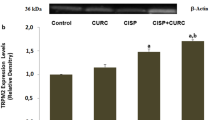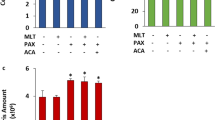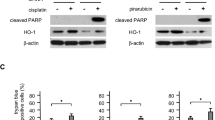Abstract
It has been previously reported that cisplatin is a well-known anticancer drug being used against a wide range of malignancies including head and neck, ovarian and non-small cell lung carcinoma, and demonstrated its anticancer activity by reacting with DNA or changing cell structure, immune response, reactive oxygen species level (ROS). In this research we proved that cisplatin induced cell injuries and heme oxygenase-1 (HO-1) expression in laryngeal squamous cell cancer Hep-2 cells through ROS generation. The induction of HO-1 clearly protected Hep-2 cells from cisplatin-induced cell death and ROS reaction, and the inhibitor of HO-1 enhanced the cell death and ROS generation induced by cisplatin. Furthermore, the HO-1 expression induced by cisplatin was strongly inhibited by the knockdown of nuclear factor-erythroid-2-related factor-2 (Nrf-2), and the oxidative damages induced by cisplatin were significantly enhanced. Therefore, it may be concluded that the inhibition of HO-1 or the knockdown of Nrf-2 significantly enhanced cisplatin’s anticancer effects on Hep-2 cells. In clinic, with the overexpression of HO-1 in laryngeal squamous cancer tissues, the combination of cisplatin with the inhibitor of HO-1 or Nrf-2 siRNA may act as a new method to the treatment of laryngeal squamous cancer.







Similar content being viewed by others
Abbreviations
- ARE:
-
Antioxidant response element
- DCFH-DA:
-
Dichlorofluorescin diacetate
- HO-1:
-
Heme oxygenase-1
- Nrf-2:
-
Nuclear factor-erythroid-2-related factor-2
- PBS:
-
Phosphate-buffered saline
- PI:
-
Propidium iodide
- ROS:
-
Reactive oxygen species
- ZnPPIX:
-
Zinc protoporphyrin IX
References
Schorn VJ, Miles BA (2014) Laryngeal squamous cell carcinoma. In: Lin F, Patel Z (eds) ENT board prep. Springer, New York, pp 227–233
Nadal A, Cardesa A (2003) Molecular biology of laryngeal squamous cell carcinoma. Virchows Arch 442:1–7
Sato I, Umemura M, Mitsudo K, Feng X, Nakashima H, Kioi M, Miyajima A, Eguchi H, Tohnai I, Ishikawa Y (2014) Development of thermochemotherapy using cisplatin and ferucarbotran (Resovist®) in head and neck cancer. Cancer Res 74:4576
Hitt R, Lopez-Pousa A, Martinez-Trufero J, Escrig V, Carles J, Rizo A, Isla D, Vega ME, Marti JL, Lobo F, Pastor P, Valenti V, Belon J, Sanchez MA, Chaib C, Pallares C, Anton A, Cervantes A, Paz-Ares L, Cortes-Funes H (2005) Phase III study comparing cisplatin plus fluorouracil to paclitaxel, cisplatin, and fluorouracil induction chemotherapy followed by chemoradiotherapy in locally advanced head and neck cancer. J Clin Oncol 23:8636–8645
Toyozumi Y, Arima N, Izumaru S, Kato S, Morimatsu M, Nakashima T (2004) Loss of caspase-8 activation pathway is a possible mechanism for CDDP resistance in human laryngeal squamous cell carcinoma, HEp-2 cells. Int J Oncol 25:721–728
Xiang C, Lv Y, Wei Y, Wei J, Miao S, Mao X, Gu X, Song K, Jia S (2015) Effect of EphA7 silencing on proliferation, invasion and apoptosis in human laryngeal cancer cell lines Hep-2 and AMC-HN-8. Cell Physiol Biochem 36:435–445
Kang R, Wang Z, Wang B, Zhang C, Gao W, Feng Y, Bai T, Zhang H, Huang-Pu H, Wen S (2012) Inhibition of autophagy-potentiated chemosensitivity to cisplatin in laryngeal cancer Hep-2 cells. Am J Otolaryngol 33:678–684
Zhang F, Yang B, Shi S, Jiang X (2014) RNA interference (RNAi) mediated stable knockdown of protein casein kinase 2-alpha (CK2α) inhibits migration and invasion and enhances cisplatin-induced apoptosis in HEp-2 laryngeal carcinoma cells. Acta Histochem 116:1000–1006
Dasari S, Tchounwou PB (2014) Cisplatin in cancer therapy: molecular mechanisms of action. Eur J Pharmacol 740:364–378
Barry MA, Behnke CA, Eastman A (1990) Activation of programmed cell death (apoptosis) by cisplatin, other anticancer drugs, toxins and hyperthermia. Biochem Pharmacol 40:2353–2362
Kim H, Kim S, Kim E, Park J, Yang S, Jeong E, Park C, Youn M, So H, Park R (2008) Suppression of Nrf2-driven heme oxygenase-1 enhances the chemosensitivity of lung cancer A549 cells toward cisplatin. Lung Cancer 60:47–56
Longchar A, Prasad SB (2015) Biochemical changes associated with ascorbic acid–cisplatin combination therapeutic efficacy and protective effect on cisplatin-induced toxicity in tumor-bearing mice. Toxicol Rep 2:489–503
Liu T, Peng H, Zhang M, Deng Y, Wu Z (2010) Cucurbitacin B, a small molecule inhibitor of the Stat3 signaling pathway, enhances the chemosensitivity of laryngeal squamous cell carcinoma cells to cisplatin. Eur J Pharmacol 641:15–22
Wang L, Li Y, Yang S, Wang F, Hou Y, Cui W, Chen K, Cao Q, Wang S, Zhang T (2014) Gambogic acid synergistically potentiates cisplatin-induced apoptosis in non-small-cell lung cancer through suppressing NF-κB and MAPK/HO-1 signalling. Br J Cancer 110:341–352
Ghosh P, Singha Roy S, Basu A, Bhattacharjee A, Bhattacharya S (2015) Sensitization of cisplatin therapy by a naphthalimide based organoselenium compound through modulation of antioxidant enzymes and p53 mediated apoptosis. Free Radic Res 49:453–471
Chen J, Solomides C, Parekh H, Simpkins F, Simpkins H (2015) Cisplatin resistance in human cervical, ovarian and lung cancer cells. Cancer Chemother Pharmacol 75:1217–1227
Sahin K, Tuzcu M, Gencoglu H, Dogukan A, Timurkan M, Sahin N, Aslan A, Kucuk O (2010) Epigallocatechin-3-gallate activates Nrf2/HO-1 signaling pathway in cisplatin-induced nephrotoxicity in rats. Life Sci 87:240–245
Das R, Bhattacharya K, Samanta SK, Pal BC, Mandal C (2014) Improved chemosensitivity in cervical cancer to cisplatin: synergistic activity of mahanine through STAT3 inhibition. Cancer Lett 351:81–90
Tayem Y, Green CJ, Motterlini R, Foresti R (2014) Isothiocyanate–cysteine conjugates protect renal tissue against cisplatin-induced apoptosis via induction of heme oxygenase-1. Pharmacol Res 81:1–9
Lee J, Johnson JA (2004) An important role of Nrf2-ARE pathway in the cellular defense mechanism. BMB Rep 37:139–143
Kumar KS, Liao J, Xiao J, Vani MG, Wang S (2012) Hepatoprotective effect of lucidone against alcohol-induced oxidative stress in human hepatic HepG2 cells through the up-regulation of HO-1/Nrf-2 antioxidant genes. Toxicol In Vitro 26:700–708
Chen J, Huang P, Wang C, Lin F, Tsai H, Wu T, Lin S, Chen J (2011) Nrf-2 mediated heme oxygenase-1 expression, an antioxidant-independent mechanism, contributes to anti-atherogenesis and vascular protective effects of Ginkgo biloba extract. Atherosclerosis 214:301–309
Fang J, Akaike T, Maeda H (2004) Antiapoptotic role of heme oxygenase (HO) and the potential of HO as a target in anticancer treatment. Apoptosis 9:27–35
Gotoh Y, Cooper JA (1998) Reactive oxygen species-and dimerization-induced activation of apoptosis signal-regulating kinase 1 in tumor necrosis factor-α signal transduction. J Biol Chem 273:17477–17482
Zhang R, Humphreys I, Sahu RP, Shi Y, Srivastava SK (2008) In vitro and in vivo induction of apoptosis by capsaicin in pancreatic cancer cells is mediated through ROS generation and mitochondrial death pathway. Apoptosis 13:1465–1478
Xing H, Liu Y, Chen J, Sun F, Shi H, Xia P (2011) Hyperoside attenuates hydrogen peroxide-induced L02 cell damage via MAPK-dependent Keap 1-Nrf 2-ARE signaling pathway. Biochem Biophys Res Commun 410:759–765
Kim SE, Lee MY, Lim SC, Hien TT, Kim JW, Ahn S, Yoon J, Kim SK, Choi HS, Kang KW (2010) Role of Pin1 in neointima formation: down-regulation of Nrf2-dependent heme oxygenase-1 expression by Pin1. Free Radic Biol Med 48:1644–1653
Wang J, Yuan L, Xiao H, Xiao C, Wang Y, Liu X (2013) Momordin Ic induces HepG2 cell apoptosis through MAPK and PI3 K/Akt-mediated mitochondrial pathways. Apoptosis 18:751–765
Lee Y, Jeong H, Kim Y, Lee Y, Won SY, Shim J, Cho M, Nam H, Lee S (2012) Reactive oxygen species and PI3 K/Akt signaling play key roles in the induction of Nrf2-driven heme oxygenase-1 expression in sulforaphane-treated human mesothelioma MSTO-211H cells. Food Chem Toxicol 50:116–123
Marzano C, Gandin V, Folda A, Scutari G, Bindoli A, Rigobello MP (2007) Inhibition of thioredoxin reductase by auranofin induces apoptosis in cisplatin-resistant human ovarian cancer cells. Free Radic Biol Med 42:872–881
Berberat PO, Dambrauskas Z, Gulbinas A, Giese T, Giese N, Kunzli B, Autschbach F, Meuer S, Buchler MW, Friess H (2005) Inhibition of heme oxygenase-1 increases responsiveness of pancreatic cancer cells to anticancer treatment. Clin Cancer Res 11:3790–3798
El-Najjar N, Chatila M, Moukadem H, Vuorela H, Ocker M, Gandesiri M, Schneider-Stock R, Gali-Muhtasib H (2010) Reactive oxygen species mediate thymoquinone-induced apoptosis and activate ERK and JNK signaling. Apoptosis 15:183–195
Liu Y, Liang Y, Zheng T, Yang G, Zhang X, Sun Z, Shi C, Zhao S (2011) Inhibition of heme oxygenase-1 enhances anti-cancer effects of arsenic trioxide on glioma cells. J Neurooncol 104:449–458
Ravindran J, Gupta N, Agrawal M, Bhaskar AB, Rao PL (2011) Modulation of ROS/MAPK signaling pathways by okadaic acid leads to cell death via, mitochondrial mediated caspase-dependent mechanism. Apoptosis 16:145–161
Yin H, Fang J, Liao L, Maeda H, Su Q (2014) Upregulation of heme oxygenase-1 in colorectal cancer patients with increased circulation carbon monoxide levels, potentially affects chemotherapeutic sensitivity. BMC Cancer 14:436
Na H, Surh Y (2014) Oncogenic potential of Nrf2 and its principal target protein heme oxygenase-1. Free Radic Biol Med 67:353–365
Pongrakhananon V, Nimmannit U, Luanpitpong S, Rojanasakul Y, Chanvorachote P (2010) Curcumin sensitizes non-small cell lung cancer cell anoikis through reactive oxygen species-mediated Bcl-2 downregulation. Apoptosis 15:574–585
Huang C, Zhang P, Wang W, Xu Y, Wang M, Chen X, Dong X (2014) Long-term blue light exposure induces RGC-5 cell death in vitro: involvement of mitochondria-dependent apoptosis, oxidative stress, and MAPK signaling pathways. Apoptosis 19:922–932
Furfaro AL, Macay JRZ, Marengo B, Nitti M, Parodi A, Fenoglio D, Marinari UM, Pronzato MA, Domenicotti C, Traverso N (2012) Resistance of neuroblastoma GI-ME-N cell line to glutathione depletion involves Nrf2 and heme oxygenase-1. Free Radic Biol Med 52:488–496
Sui X, Kong N, Ye L, Han W, Zhou J, Zhang Q, He C, Pan H (2014) p38 and JNK MAPK pathways control the balance of apoptosis and autophagy in response to chemotherapeutic agents. Cancer Lett 344:174–179
Zhang H, Liu Y, Jiang Q, Li K, Zhao Y, Cao C, Yao J (2014) Salvianolic acid A protects RPE cells against oxidative stress through activation of Nrf2/HO-1 signaling. Free Radic Biol Med 69:219–228
Bodduluru LN, Kasala ER, Thota N, Barua CC, Sistla R (2014) Chemopreventive and therapeutic effects of nimbolide in cancer: the underlying mechanisms. Toxicol In Vitro 28:1026–1035
Kim JY, Yu S, Oh HJ, Lee JY, Kim Y, Sohn J (2011) Panaxydol induces apoptosis through an increased intracellular calcium level, activation of JNK and p38 MAPK and NADPH oxidase-dependent generation of reactive oxygen species. Apoptosis 16:347–358
Li X, Wang K, Ren Y, Zhang L, Tang X, Zhang H, Zhao C, Liu P, Zhang J, He J (2014) MAPK signaling mediates sinomenine hydrochloride-induced human breast cancer cell death via both reactive oxygen species-dependent and-independent pathways: an in vitro and in vivo study. Cell Death Dis 5:e1356
Jozkowicz A, Was H, Dulak J (2007) Heme oxygenase-1 in tumors: is it a false friend? Antioxid Redox Signal 9:2099–2118
Was H, Dulak J, Jozkowicz A (2010) Heme oxygenase-1 in tumor biology and therapy. Curr Drug Targets 11:1551–1570
Arnold JN, Magiera L, Kraman M, Fearon DT (2014) Tumoral immune suppression by macrophages expressing fibroblast activation protein-alpha and heme oxygenase-1. Cancer Immunol Res 2:121–126
Dunn LL, Midwinter RG, Ni J, Hamid HA, Parish CR, Stocker R (2014) New insights into intracellular locations and functions of heme oxygenase-1. Antioxid Redox Signal 20:1723–1742
Gueron G, Giudice J, Valacco P, Paez A, Elguero B, Toscani M, Jaworski F, Leskow FC, Cotignola J, Marti M, Binaghi M, Navone N, Vazquez E (2014) Heme-oxygenase-1 implications in cell morphology and the adhesive behavior of prostate cancer cells. Oncotarget 5:4087–4102
Gandini NA, Fermento ME, Salomón DG, Obiol DJ, Andrés NC, Zenklusen JC, Arevalo J, Blasco J, Romero AL, Facchinetti MM (2014) Heme oxygenase-1 expression in human gliomas and its correlation with poor prognosis in patients with astrocytoma. Tumor Biol 35:2803–2815
Chau LY (2015) Heme oxygenase-1: emerging target of cancer therapy. J Biomed Sci 22:22-015-0128-0
Wegiel B, Hedblom A, Li M, Gallo D, Csizmadia E, Harris C, Nemeth Z, Zuckerbraun B, Soares M, Persson JL (2014) Heme oxygenase-1 derived carbon monoxide permits maturation of myeloid cells. Cell Death Dis 5:e1139
Gao SS, Choi B, Chen XY, Zhu RZ, Kim Y, So H, Park R, Sung M, Kim B (2010) Kaempferol suppresses cisplatin-induced apoptosis via inductions of heme oxygenase-1 and glutamate-cysteine ligase catalytic subunit in HEI-OC1 cells. Pharm Res 27:235–245
Ahn J, Won M, Choi J, Kim YS, Jung C, Im D, Kyun M, Lee K, Song K, Chung K (2013) Reactive oxygen species-mediated activation of the Akt/ASK1/p38 signaling cascade and p21Cip1 downregulation are required for shikonin-induced apoptosis. Apoptosis 18:870–881
Bragado P, Armesilla A, Silva A, Porras A (2007) Apoptosis by cisplatin requires p53 mediated p38α MAPK activation through ROS generation. Apoptosis 12:1733–1742
Zhang Z, Wu Y, Liang H, Zhang B, Zhang W (2015) MAPK/ERK activation sensitizes MKN-28 cells to cisplatin-induced apoptosis. Cancer Stud Mol Med Open J 2:52–59
Acknowledgments
This study was supported by Grants from Natural Science Foundation of Hebei province (H2013206264).
Author information
Authors and Affiliations
Corresponding author
Ethics declarations
Conflict of interest
There is no report to declare the conflict of interest.
Additional information
Xin Lv and Dong-mei Song have contributed equally to this work.
Electronic supplementary material
Below is the link to the electronic supplementary material.
Rights and permissions
About this article
Cite this article
Lv, X., Song, Dm., Niu, Yh. et al. Inhibition of heme oxygenase-1 enhances the chemosensitivity of laryngeal squamous cell cancer Hep-2 cells to cisplatin. Apoptosis 21, 489–501 (2016). https://doi.org/10.1007/s10495-016-1216-7
Published:
Issue Date:
DOI: https://doi.org/10.1007/s10495-016-1216-7




